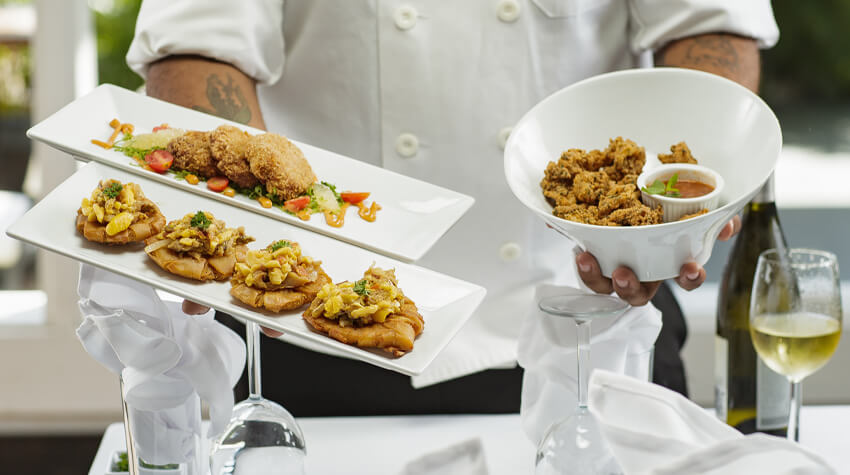In the quest for foodservice profitability, operators face the persistent challenge of skyrocketing food costs. In a National Restaurant Association survey, 92% of operators identify rising food costs as a critical issue.1 The mission is clear: devise solutions to mitigate this concern while ensuring sustained financial resilience. Here are three winning strategies to consider.
Rethink inventory
Begin reorienting your inventory by eliminating low-performing ingredients and menu items. As a cost-reducing measure, 59% of operators participating in the National Restaurant Association survey have already changed the food and beverage items they offer.1
Casual dining chain O’Charley’s Restaurant & Bar pared down the menu, created new specials for specific days of the week and added new menu items with ingredients the kitchen already had on hand, according to CEO Craig Barber.2 For example, the operator recently launched its Loaded Mac and Cheese Tender Bowl on the kids’ menu that simply reuses the already-popular mac and cheese and chicken tenders. “We create new offerings that are attractive to guests from an affordability standpoint but also helped us to maintain margins to sustain the business overall,” Barber said.2
Besides streamlining your menu item count, make the ingredients themselves count. Use high-quality ingredients with claims that consumers are willing to pay more for. This helps you and your guests justify higher menu pricing. For example, according to a recent survey, consumers indicate a willingness to pay more for poultry dishes with the following claims:3
● Clean Label with No Chemicals/Preservatives (76%)
● No Antibiotics Ever (73%)
● Responsibly Raised/Industry-Leading Animal Care (67%)
● Free Range/Organic (67%)
● All Vegetarian Fed with No Animal By-Products (57%)3
Leverage stable pricing
Purchase more frozen and shelf-stable products in order to gain stable pricing. Some 40% of foodservice operators are now sourcing more frozen foods than they did in 2019, according to Restaurant Business. Already 90% of operators report utilizing frozen foods, and 75% report increased purchases of frozen appetizers, which is the fastest-growing frozen category.4
Frozen foods overall are more price-stable, allowing for cheaper bulk purchasing, extended storage time and reduced out-of-stocks. Many frozen products are also portion-controlled allowing for consistency.
Imagine the difference it would make in controlling food costs if your top 10 ingredients were price stable, perhaps through purchasing frozen or shelf-stable products. Then, track your inventory daily to make sure you have a good supply of those key ingredients. Last-minute purchases are often the most costly.5
Control waste and reduce labor
Reducing waste is another sure method to control food costs. The more in-house prep you do, the more product that you paid for goes to the scrap heap from trimming. Waste also happens when fresh food goes bad or is improperly prepared.
Purchasing pre-cooked and/or pre-breaded proteins can help to reduce labor and control waste. 84% of foodservice operators agree that frozen foods produce less waste.4 Frozen options can help minimize waste since these products last longer than fresh.
Create LTOs that utilize ingredients you already have. Specials breathe excitement and provide a promotional opportunity for an otherwise static menu.
Limited time offers became a game plan after Red Robin Gourmet Burgers Inc. streamlined its menu during the pandemic. The casual dining brand has no plans to broaden its menu back to pre-pandemic levels because it would add operational complexity. Rather it relies on limited time offerings to keep the menu fresh and exciting, according to an earnings call.7
In the event food costs keep going up, adjust your menu management by getting the most out of your ingredients and rethinking the role of frozen, pre-cooked and ready-to-cook items. You will not sacrifice flavor or quality in doing so, but rather you will add a layer of dish consistency and reduced waste while controlling costs.
Sources
- “Restaurant Operators End 2022 With Mixed Outlook,” National Restaurant Association, Jan. 5, 2023, https://restaurant.org/research-and-media/media/press-releases/restaurant-operators-end-2022-with-mixed-outlook/
- Fantozzi, Joanna, “O’Charley’s is Investing in Inflation-era Strategies Beyond Raising Prices,” Nation’s Restaurant News, Dec. 12, 2022, https://www.nrn.com/casual-dining/o-charley-s-investing-inflation-era-strategies-beyond-raising-prices
- Perdue Proprietary Research, May 2022
- Cobe, Patricia, “Operators are Sourcing More Frozen Foods to Meet Labor, Supply and Waste Challenges,” Restaurant Business, Nov. 2, 2022, https://www.restaurantbusinessonline.com/operations/operators-are-sourcing-more-frozen-foods-meet-labor-supply-waste-challenges
- Cobe, Patricia, “Wild Swings in Food Costs Force Restaurants to Rethink Menus,” Restaurant Business, Nov. 30, 2022, https://www.restaurantbusinessonline.com/operations/wild-swings-food-costs-force-restaurants-rethink-menus
- Wheaton, Sean, “How Sous Vide Can Help Recession-proof Restaurants,” Modern Restaurant Management, Dec. 13, 2022, https://modernrestaurantmanagement.com/how-sous-vide-can-help-recession-proof-restaurants/
- Ruggless, Ron, “Red Robin Plans to Continue Streamlined Menu,” Nation’s Restaurant News, May 27, 2022, https://www.nrn.com/casual-dining/red-robin-plans-continue-streamlined-menu

